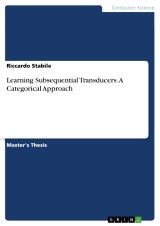Details

Learning Subsequential Transducers. A Categorical Approach
1. Auflage
|
36,99 € |
|
| Verlag: | Grin Verlag |
| Format: | |
| Veröffentl.: | 24.04.2024 |
| ISBN/EAN: | 9783389015643 |
| Sprache: | englisch |
| Anzahl Seiten: | 88 |
Dieses eBook erhalten Sie ohne Kopierschutz.
Beschreibungen
Master's Thesis from the year 2024 in the subject Computer Sciences - Artificial Intelligence, Università degli Studi di Milano (Dipartimento di Matematica), course: Corso di Laurea Magistrale in Matematica, language: English, abstract: In this thesis, an algorithm for learning subsequential transducers is presented from two different perspectives: as an extension of Angluin's algorithm for learning deterministic finite automata and as an instantiation of a more generic categorical algorithm valid for a larger class of automata. The adopted categorical approach considers automata as functors from a category representing words to a certain output category. Some sufficient properties for yielding the existence of minimal automata are presented, together with some additional hypotheses relative to termination to ensure the correctness of the generic algorithm. Remarkably, the conditions required in Angluin’s original algorithm and in its extended version for subsequential transducers naturally arise as the generic categorical algorithm is instantiated with the proper output categories.
It is not uncommon to understand facts, processes and results better by looking at them from above: learning is not an exception. Learning is a crucial area in computer science, especially in artificial intelligence: knowing how to deal with communication, mistakes and experience plays an essential role to progress in learning. But even more important is learning what makes communication possible: a language. A language can be initially thought as a subset of a set of words over an alphabet, always supposed to be finite.The relation between languages and automata has become clearer and clearer in the last decades, since Noam Chomsky gave a mathematical model of a grammar in the second half of the last century.
A deterministic finite automaton accepts a language, called regular, and for every regular language there exists a deterministic finite automaton being minimal, i.e. with a minimal number of states, that accepts it. An analogous thing happens for subsequential transducers, which are automata more complex than deterministic finite automata: in this case, some partial functions, called subsequential, from a set of words to another over possibly different alphabets are accepted;asubsequential transducer accepts a particular subsequential function and for every subsequential function there exists a minimal subsequential transducer accepting it. This is the reason why learning regular languages and subsequential functions may be pursued by learning the minimal automata accepting them.
It is not uncommon to understand facts, processes and results better by looking at them from above: learning is not an exception. Learning is a crucial area in computer science, especially in artificial intelligence: knowing how to deal with communication, mistakes and experience plays an essential role to progress in learning. But even more important is learning what makes communication possible: a language. A language can be initially thought as a subset of a set of words over an alphabet, always supposed to be finite.The relation between languages and automata has become clearer and clearer in the last decades, since Noam Chomsky gave a mathematical model of a grammar in the second half of the last century.
A deterministic finite automaton accepts a language, called regular, and for every regular language there exists a deterministic finite automaton being minimal, i.e. with a minimal number of states, that accepts it. An analogous thing happens for subsequential transducers, which are automata more complex than deterministic finite automata: in this case, some partial functions, called subsequential, from a set of words to another over possibly different alphabets are accepted;asubsequential transducer accepts a particular subsequential function and for every subsequential function there exists a minimal subsequential transducer accepting it. This is the reason why learning regular languages and subsequential functions may be pursued by learning the minimal automata accepting them.
Diese Produkte könnten Sie auch interessieren:

Autonomic Communication

von: Athanasios V. Vasilakos, Manish Parashar, Stamatis Karnouskos, Witold Pedrycz

149,79 €















